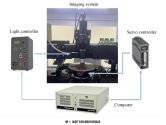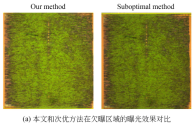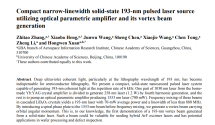OF course TSMC is not just bigger that SMIC, they are bigger than everyone else. They make the most expensive chips out there. I think in revenue, 8 billion put SMIC the second largest foundry in the planet and given how things are going SMIC is hell bent to capture a big chunk of the huge Chinese market, I think they could reach like 25%-30% of the global revenue if they mass produce 14/7/5nm, which of course will cause an absolute panic in Taipei.8 billion vs 73 billion for tsmc. Seems so disappointing. I thought SMIC was a big deal but its revenue is so little compared to tsmc. And it's Capex is laughable.
If US tech firms can spend 100 billion per year each on just data center construction then China should be spending 500 billion on semiconductors and out of those 500, 100 billion should be spent by smic considering they are the leading fab Corp.
China should really step up the game if they truly want to catch up. Invest big in smic and help them grow faster.
You are using an out of date browser. It may not display this or other websites correctly.
You should upgrade or use an alternative browser.
You should upgrade or use an alternative browser.
Chinese semiconductor thread II
- Thread starter vincent
- Start date
It's not alarmism, I know China is making progress. But compared to the kind of money US tech firms are throwing at AI vs what China's big fund is spending is a bit disappointing. Especially when you look at the media articles which constantly talk about how China is spending huge on semiconductors. But the actual numbers are really low compared to even one US big tech company. China's total GDP is now 20 trillion dollars. Considering the national importance of Chip self reliance, The national Chip spending should be several 100 billion compared to current big fund budget of just 48 billion.
There's something called diminishing marginal returns on investment.
Just because it takes 1 woman 9 months to make a baby, doesn't mean you can get 9 women to make a baby in 1 month.
Similarly, if it takes $10b/year over 10 years to get to volume production of 3/4/5 nm, you can't get there in a year by spending $100b.
Xingfu Electronics, a leader in wet electronic chemicals, is listed on the A-share market
Hubei Xingfu Electronic Materials Co., Ltd. (Xingfu Electronics), a leading company in the field of wet electronic chemicals in China, was officially listed on the Science and Technology Innovation Board of the Shanghai Stock Exchange. Xingfu Electronics made its first public offering on January 14 and was listed on the Science and Technology Innovation Board. The online subscription and winning rate announcement was released.
Xingfu Electronics was established in 2008 and is one of the earliest companies in China to engage in wet electronic chemicals business. Xingfu Electronics is a subsidiary of Xingfa Group, a listed company. Hubei Xingfa Chemical Group Co., Ltd. was established in 1994. It is a listed company whose main business is the development, production and sales of phosphorus chemical products and fine chemical products. The company was listed on the Shanghai Stock Exchange in 1999. Wet electronic chemicals are indispensable key basic materials in the electronics industry and can be used in the manufacturing process of terminal products in the fields of integrated circuits, display panels, solar photovoltaics, etc. According to different components and application processes, wet electronic chemicals are divided into two categories: general wet electronic chemicals and functional wet electronic chemicals.
Main products:In addition to electronic-grade phosphoric acid products with absolute domestic advantages, Xingfu Electronics has also developed electronic-grade sulfuric acid and functional wet electronic chemicals, with multiple product lines. Functional wet electronic chemicals play an important role in the field of advanced semiconductor processes. Xingfu Electronics has developed 60 functional wet electronic chemical products in five categories, including etching solutions, cleaning agents, developers, stripping solutions, and regeneration agents, according to different customer needs; it has currently supplied many well-known integrated circuit and display panel industry companies, including SMIC, Yangtze Memory Technologies, BYD Semiconductor, and Shenzhen Huaxing Optoelectronics.

this massage proved you absolutely know nothing about semiconductor.8 billion vs 73 billion for tsmc. Seems so disappointing. I thought SMIC was a big deal but its revenue is so little compared to tsmc. And it's Capex is laughable.
If US tech firms can spend 100 billion per year each on just data center construction then China should be spending 500 billion on semiconductors and out of those 500, 100 billion should be spent by smic considering they are the leading fab Corp.
China should really step up the game if they truly want to catch up. Invest big in smic and help them grow faster.
let suppose, someone tell Chinese government if you allocate 100 billion then tomorrow China will be self-sufficient in advanced semiconductor. i m damn sure administration would love to give even 200 billion. you seriously believe Richest government on planet earth couldn't spend 50-100 billion.. but semi fabs don't work like this.
suppose it took TSMC 5-7 years to start volume production of 5nm/3nm. but you can't get there in a year by spending $100b.. China also take the same steps maybe little faster. for example SMIC 7nm/7+nm took lesser time.
SMIC also completed the R&D of 5nm and 3nm but awaiting EUV and other tools. please start reading this thread.
and for your kind information.. TSMC capex is $38-$42 billion for 2025 year..
the national IC big fund made two invest of total ¥164 billion out of its phase 3 funding pool. 1st/2nd investment was established in May 2024. Phase 3 has gathered total funding of 344 billion RMB.. and this is just the one investment fund.The national Chip spending should be several 100 billion compared to current big fund budget of just 48 billion.
--------------------------------------------------------------------
Phase II
in 2023, China launched a new state-backed investment fund that aims to raise about 300 billion RMB for its semiconductor sector.
------------------------------------------------------------------------
last month, The Bank of China, has announced its decision to provide at least 1 trillion Yuan in funding to companies in the Artificial Intelligence related industries. this is also indirectly support to advanced semiconductor .
if you summed up all, then total funding goes beyond 2+ Trillion RMB.. you know what, how massive this amount is in China. and for GOD sake, don't compare Dollar with RMB in China.. conversation rate is useless in mainland coz of reasons. this is actually several 100 billions in mainland China. the real money.
Last edited:
Research in wafer metrology equipment



Fast and uniform exposure control for wafer flying imaging system
summary
The exposure control of wafer flying imaging system has a significant impact on the imaging quality. The traditional exposure control algorithm based on spatial domain evaluation is complex in calculation and ignores the difference of grain characteristics, which easily leads to uneven exposure. To this end, an exposure control method based on image partition frequency domain evaluation is proposed. This method adopts a block-based dual threshold segmentation algorithm to adaptively segment the characteristic area of the grain image; combines the high-pass filter and Gaussian pyramid algorithm to quickly extract the high-frequency information of the image in the frequency domain, and designs a regional weighted evaluation function to comprehensively evaluate the exposure effect. In order to realize the rapid search of the optimal exposure parameters within the maximum exposure time, a variable step search algorithm based on decision tree is proposed. The comparative experimental results show that: under the premise of ensuring the accuracy, the search algorithm improves the average quality index of the best image by 1.34%, reduces the exposure parameter adjustment time by 61.3%, and ensures the imaging quality in the wafer flying imaging process.
Abstract
The exposure control of wafer motion imaging systems greatly affects image quality. Traditional spatial domain-based algorithms are complex and overlook differences in die features, causing uneven exposure. To solve this, we propose a method using frequency domain evaluation through image partitioning. This method uses a block-based dual-threshold segmentation algorithm to adaptively segment image features. By combining high-pass filtering with a Gaussian pyramid algorithm, it efficiently extracts high-frequency information. decision tree-based search algorithm with variable steps is introduced to quickly find optimal exposure parameters. Experiments show this algorithm improves image quality by 1.34% and reduces exposure adjustment time by 61.3%, ensuring fast imaging quality in wafer motion imaging.
The exposure control of wafer flying imaging system has a significant impact on the imaging quality. The traditional exposure control algorithm based on spatial domain evaluation is complex in calculation and ignores the difference of grain characteristics, which easily leads to uneven exposure. To this end, an exposure control method based on image partition frequency domain evaluation is proposed. This method adopts a block-based dual threshold segmentation algorithm to adaptively segment the characteristic area of the grain image; combines the high-pass filter and Gaussian pyramid algorithm to quickly extract the high-frequency information of the image in the frequency domain, and designs a regional weighted evaluation function to comprehensively evaluate the exposure effect. In order to realize the rapid search of the optimal exposure parameters within the maximum exposure time, a variable step search algorithm based on decision tree is proposed. The comparative experimental results show that: under the premise of ensuring the accuracy, the search algorithm improves the average quality index of the best image by 1.34%, reduces the exposure parameter adjustment time by 61.3%, and ensures the imaging quality in the wafer flying imaging process.
Abstract
The exposure control of wafer motion imaging systems greatly affects image quality. Traditional spatial domain-based algorithms are complex and overlook differences in die features, causing uneven exposure. To solve this, we propose a method using frequency domain evaluation through image partitioning. This method uses a block-based dual-threshold segmentation algorithm to adaptively segment image features. By combining high-pass filtering with a Gaussian pyramid algorithm, it efficiently extracts high-frequency information. decision tree-based search algorithm with variable steps is introduced to quickly find optimal exposure parameters. Experiments show this algorithm improves image quality by 1.34% and reduces exposure adjustment time by 61.3%, ensuring fast imaging quality in wafer motion imaging.



It's not alarmism, I know China is making progress. But compared to the kind of money US tech firms are throwing at AI vs what China's big fund is spending is a bit disappointing. Especially when you look at the media articles which constantly talk about how China is spending huge on semiconductors. But the actual numbers are really low compared to even one US big tech company. China's total GDP is now 20 trillion dollars. Considering the national importance of Chip self reliance, The national Chip spending should be several 100 billion compared to current big fund budget of just 48 billion.
Alright, you are banned for one week from this thread. And I hope you take this time to read and learn from others rather than keep spewing nonsense.
Hybrid active–passive vibration isolation based on the superconducting magnetic levitation: Modelling, simulation and validation.
Abstract
Vibration control plays an important role in the development of high-precision instruments and machinery such as high-resolution optical remote sensing telescope and wafer stepper lithography machine. In this paper, we developed an active–passive hybrid vibration isolation system based on the superconducting magnetic levitation technology to suppress or eliminate the adverse effect caused by the low-to-medium frequency vibrations on the sensitive payloads. We formulated a vibration model for the superconducting levitation system, and analyzed the levitation force, the equivalent magnetic stiffness, damping coefficients, and the vibration characteristics of the system. Then, a vibration isolator, consisting of 7 superconducting bulks, a permanent magnet, electric coil, and the controller etc., is designed. The vibration response of the isolator under normal gravity and microgravity environment is predicted through theoretical analysis and numerical simulations, and the vibration isolation performance of the isolator is verified through vibration excitation experiment. Our study shows that the hybrid active–passive vibration isolation based on the superconducting magnetic levitation has a great application potential in the micro-vibration isolation and control, which is with the merit of non-contact, stable levitation, and high vibration isolation performance in the low-to-medium frequency band.
Suci Technology won the Ningbo Jisi Quality Supplier
Recently, the 2025 theme annual meeting of Ningbo Jisi Electronic Materials Co., Ltd. was successfully held. Ms. Cui Ping, Party Secretary and Director of Yongjiang Laboratory, and Dr. Su Hongjiu, Chairman and General Manager of Ningbo Jisi Electronic Materials Co., Ltd. attended the event and delivered New Year speeches. Su Magnetic Technology was invited to participate as a supplier.
In 2024, Ningbo Jisi's products passed the verification of its important customers, and it became a leading domestic CMP raw material manufacturer, which is of milestone significance for the company's development.
Among them, Suci Technology's magnetic levitation pump series products, as one of the core components of Ningbo Jisi Equipment, played a vital role in helping customers' products pass acceptance smoothly, and was therefore awarded the [Ningbo Jisi Electronic Materials Co., Ltd. 2024 Quality Supplier] award.
As a leading domestic supplier of magnetic levitation technology solutions, Suci Technology has always been committed to the application innovation of magnetic levitation bearingless technology. This honor is not only a recognition of Suci Technology's technical strength and services, but also an affirmation of its future development potential.
Looking into the future, Suci Technology will continue to provide customers with high-quality magnetic levitation pump products, maintain rapid response and high-quality services in technical support, and work with customers to expand the CMP raw material production business and create greater glory!



